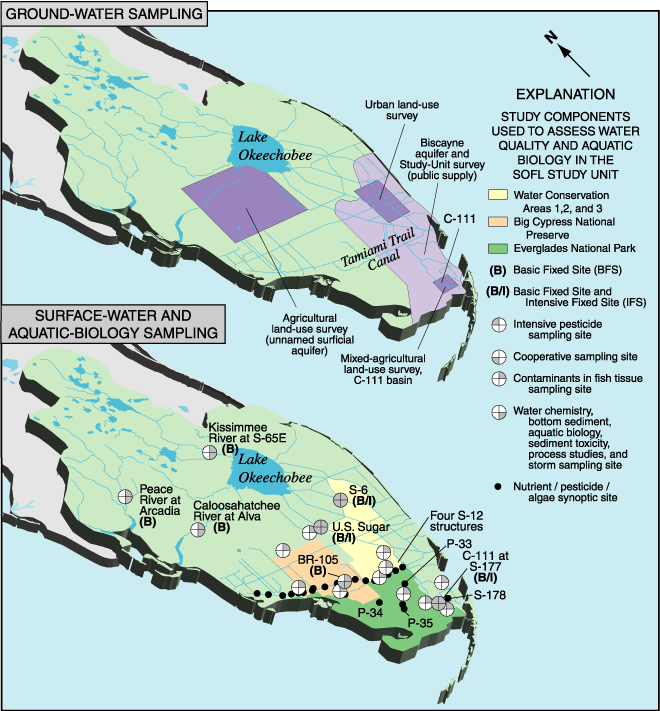STUDY UNIT DESIGN
 |
|
Study component |
Objectives |
Brief description and water-quality parameters |
Number |
Sampling frequency during water year |
Historical |
| SURFACE WATER |
|||||
| Bottom- sediment survey (BFS) |
Determine presence of potentially toxic compounds in sediment at selected sites |
Sample the depositional zone for pesticides, other synthetic organic compounds, and trace elements at water-chemistry sites |
7 |
1 |
some |
| Water-chemistry
|
Describe concentrations and loads of major ions and nutrients at selected sites |
Sample near-continuous streamflow sites for major ions, nutrients, organic carbon, and suspended sediment |
7 |
2-6 in 1996 |
data at some sites |
| Cooperative sampling program (BFS) |
Assess the influence of sampling method and location on water-quality data |
Sample water-chemistry sites on the same day as the SFWMD using both USGS methods and SFWMD methods |
5 |
2-6 in 1996 |
none |
| Storm sampling (BFS) |
Assess effects of runoff during high-flow conditions on surface-water quality |
Sample water-chemistry sites during high-flow conditions for major ions, nutrients, organic carbon, and suspended sediment |
variable |
variable |
some |
| Nutrient/
pesticide |
Determine the concentration of nutrients and pesticides across southern end of Study Unit during high and low flow |
Sample sites along the Tamiami Trail Canal during low flow (June) and high flow (August) for major ions, mercury, nutrients, organic carbon, and pesticides |
30 |
3 |
limited |
| Process studies |
Describe processes controlling the degradation and biological availability of pesticides |
Deploy and collect semipermeable membrane devices at selected sites. Collect water and bottom-sediment samples |
variable |
4 |
undeter-mined |
| Intensive
pesticide |
Determine seasonal variation in the occurrence and concentrations of nutrients and pesticides at water-chemistry sites |
Sample water-chemistry sites that are located in specified agricultural land-use areas (citrus, sugarcane, and vegetables) for nutrients and pesticides |
3 |
2 in 1996; |
some |
| GROUND WATER |
|||||
| Urban land-use survey |
Describe water quality in a residential and light commercial land-use area in a shallow aquifer susceptible to contamination |
Sample monitoring wells for major ions, nutrients, organic carbon, pesticides, radio-nuclides, trace elements, and volatile organic compounds (VOCs) |
38 wells |
1 |
some |
| Ground-water and surface-water synoptic survey |
Determine which water-quality constituents are transported through shallow ground water into surface water in an agricultural land-use area |
Sample shallow wells and surface-water sites for major ions, nutrients, pesticides, and VOCs before and during a surface-water release in a canal that drains agricultural land |
7 wells; |
1-5 |
none |
| Agricultural land-use survey |
Describe the effects of citrus land use on water quality in a shallow aquifer. |
Sample new wells for major ions, nutrients, pesticides, radionuclides, and trace elements |
30 wells |
1 |
some |
| Study-unit survey (public supply) |
Describe overall water quality in the Biscayne aquifer, which is used for drinking-water supply |
Sample existing wells for major ions, nutrients, organic carbon, pesticides, radio-nuclides, trace elements, and VOCs |
30 wells |
1 |
some |
| AQUATIC BIOLOGY |
|||||
| Contaminants |
Determine
the presence of |
Collect largemouth bass and Florida gar at a large number of sites. Sample composites of whole fish for organic compounds and fish livers for trace elements |
15 |
1 |
limited |
| Sediment |
Evaluate potential toxicity of bed sediment at the water-chemistry sites |
Collect bed-sediment samples and evaluate their potential toxicity by using ASTM methods and Hyallela azteca |
7 |
1 |
none |
| Aquatic biology |
Assess biological communities and stream habitat at the Basic Fixed Sites |
Quantitatively sample fish, macroinvertebrates, and algae near water-chemistry sites. Quantitatively describe stream habitat for these organisms |
7 |
3 |
limited |
| Algae synoptic studies |
Determine the influence of nutrients on the algal community along a nutrient gradient in the southern part of the basin |
Collect algae using artificial substrate samplers at sites across the Tamiami Trail Canal |
10-13 |
3 |
none |
| Table of Contents || Previous Section || Next Section || Glossary U.S. Geological Survey Circular 1207 Suggested citation:
|

